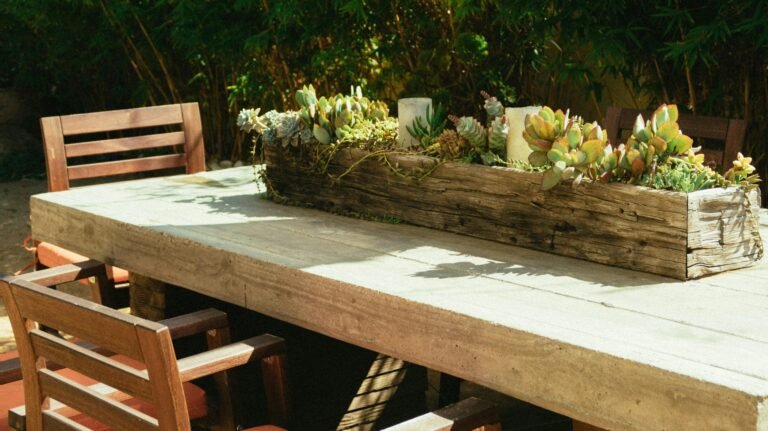You’ve got the Pinterest boards. You’ve saved the Instagram reels. And yet, every time you look out at your garden, balcony, or patio… it just doesn’t feel right.
Maybe it’s cluttered. Maybe it’s bland. Maybe it’s just not you.
You want a space that feels calm and modern—but not cold. Stylish, but not overdesigned. Something that looks like it could be in a design magazine but still lets you kick your shoes off and unwind with a drink in hand.
The problem? Minimalist garden design can be hard to pin down. Go too far, and your space feels bare. Not far enough, and it still looks chaotic.
That’s where this guide comes in. You’re about to get clear, simple tips to help you create a sleek outdoor space that’s relaxing, low-fuss, and seriously good-looking—whether you’re working with a huge garden or a city balcony.
What is Modern Minimalist Garden Design?
Let’s clear something up right away: minimalist doesn’t mean boring.
Modern minimalist garden design is all about doing more with less. It strips back the clutter and fuss so that every element—plants, furniture, pathways, pots—has a purpose and a place. It’s clean, calm, and carefully curated. Think of it as a visual deep breath.
You’ll often see:
- Neutral colour palettes – soft greys, crisp whites, natural woods.
- Strong lines and geometric shapes – in paving, planters, or raised beds.
- Open space – instead of cramming things in, minimalism values breathing room.
- Fewer plants, but chosen for impact – texture, form, and structure take priority over bright colour or variety.
This style isn’t about following strict rules. It’s about intentionality. You’re choosing simplicity over excess, calm over chaos.
Minimalist gardens can feel incredibly modern, but they can also be warm, natural, and personal. That’s the sweet spot—balancing sleek design with a lived-in, welcoming vibe.
Key Elements of a Sleek Outdoor Space
So, how do you actually build a modern minimalist garden? It starts with a few core design principles that shape everything else—from your layout to your plant choices.
1. Purposeful Space Planning
Minimalist gardens don’t just “look” tidy—they’re designed that way. Break your space into zones: a seating area, a path, a planting bed. Each one should feel distinct but connected, like part of a bigger picture. Avoid cramming too much in—leave room to breathe.
2. Simple, High-Quality Materials
Concrete, stone, timber, and metal are your best friends here. Clean finishes and smooth textures help keep the look cohesive. A matte black planter or pale timber bench adds style without shouting.
3. Neutral Colour Palettes
Stick to a tight colour scheme. Greys, whites, charcoals, and natural tones work beautifully. This doesn’t mean everything needs to be monochrome—just harmonious. Even your greenery can be part of the palette (hello, silvery eucalyptus or deep green grasses).
4. Geometric Shapes & Repetition
Straight lines and sharp angles add structure. You’ll often see rectangular paving slabs, square planters, or even circular features repeated in a rhythmic way. It keeps the space feeling unified and deliberate.
5. Less Clutter, More Impact
Resist the urge to decorate every corner. One striking sculpture, one carefully chosen piece of furniture, one architectural plant—each has more impact when it’s not competing for attention.
Minimalist Planting Ideas
Minimalist gardens aren’t about stuffing your space with as many plants as possible—they’re about choosing the right plants and using them with intention. You want structure, texture, and calm repetition.
1. Choose Plants for Shape, Not Just Colour
Forget the flowerbed explosion. In a minimalist garden, shape matters more than bloom. Think tall ornamental grasses, sculptural shrubs like box or yew, or architectural plants like agave or phormium. Their form adds interest without chaos.
2. Stick to a Limited Palette
Too many plant types can feel messy. Instead, choose just a handful—maybe three to five species—and repeat them across your space. This repetition creates rhythm and makes the space feel intentional.
3. Think Texture and Contrast
Pair smooth with spiky, soft with bold. Tall grasses next to sleek paving. Dark foliage beside pale gravel. This contrast gives depth and keeps things visually interesting without adding clutter.
4. Use Containers Strategically
Pots are a great way to keep things flexible—but stick to simple shapes and matching colours. Large, uniform planters make more of a statement than lots of small mismatched ones. And make sure what’s in them follows the same minimalist principles: structure, repetition, and harmony.
5. Go Low Maintenance
Minimalist doesn’t just mean visual simplicity—it can mean practical simplicity too. Opt for hardy, low-fuss plants that don’t demand constant care. Think lavender, sedum, Japanese maple, or evergreen grasses.
Furniture & Styling Tips
In minimalist garden design, furniture isn’t just functional—it’s part of the overall aesthetic. The goal is to add comfort and character without cluttering your space.
1. Choose Clean-Lined Pieces
Stick with sleek shapes and avoid anything too ornate. Low-profile loungers, modular seating, and simple dining sets work best. Think “quiet luxury”—comfortable, but not flashy.
2. Prioritise Function Over Filler
Ask yourself: Do I actually use this? If the answer is no, it probably doesn’t need to be there. A single bench with a view can feel more relaxing (and look better) than four scattered chairs and a side table that never gets used.
3. Stick to a Tight Colour Scheme
Echo your garden’s palette in your furniture. Black, grey, beige, white, or natural wood tones keep things cohesive. If you want a pop of colour, make it deliberate—like one cushion or planter in a bold tone.
4. Integrate Storage Smartly
Minimalism isn’t about having no “stuff”—it’s about hiding it well. Benches with storage, slimline cabinets, or built-in boxes help keep cushions, tools, or toys tucked out of sight.
5. Use Accessories Sparingly
One outdoor rug. One sculptural lantern. One bold cushion. That’s enough. The point is to let the space and materials breathe, not overload it with extras.
How to Apply This to Small Spaces
Minimalist design is practically made for small outdoor areas. Why? Because when space is limited, every item has to earn its place—and that’s the heart of minimalism.
1. Stick to the Essentials
Start with one clear purpose. Is it a spot to sit and relax? Somewhere to grow a few herbs? Trying to do everything will make it feel cramped. Choose one focus and design around that.
2. Use Vertical Space
When floor space is tight, look up. Wall-mounted planters, trellises, or slimline shelving give you room for greenery without cluttering the ground.
3. Choose Foldable or Dual-Purpose Furniture
A small bistro set that tucks away, a bench with storage, or a folding table means you can keep things sleek without sacrificing function.
4. Keep the Palette Simple
Just like in larger gardens, use a limited colour and material palette to unify the space. It helps everything feel connected and more spacious than it really is.
5. Let the Space Breathe
This is the golden rule for small-space minimalism. Don’t feel the need to fill every inch. Leaving empty space makes your balcony, patio, or rooftop feel calmer—and often bigger.
Common Mistakes to Avoid
Even with the best intentions, minimalist gardens can go off track. Here are the most common pitfalls—and how to avoid them.
1. Going Too Sparse
Minimalist doesn’t mean empty. If you remove too much, your garden can feel cold or unfinished. Aim for balance: simplicity with personality. Use a few bold pieces or plants to anchor the space.
2. Mixing Too Many Materials
Using stone, timber, metal, gravel, and concrete all at once can kill the minimalist vibe. Stick to two or three complementary materials and repeat them throughout.
3. Ignoring Practicality
Looks are important—but comfort matters too. If your seating isn’t usable, or your layout doesn’t make sense, you’ll end up avoiding the space altogether. Minimalist doesn’t mean impractical.
4. Lack of Cohesion
Random pots, clashing furniture styles, and mismatched lighting all chip away at the calm effect you’re going for. Choose pieces that feel like they belong together.
5. Overdecorating at the End
You’ve created a clean, sleek space… and then you start layering in fairy lights, garden gnomes, scatter cushions, candles, planters, wind chimes. Don’t undo your good work. Add finishing touches intentionally—one or two, not twenty.
Final Tips & Inspiration to Get Started
You don’t need a landscaping degree or a massive budget to create a sleek, modern minimalist garden. You just need a clear vision and the confidence to keep things simple.
Final Tips:
- Start small. Focus on one corner or feature first—like a seating area or a clean row of planters.
- Let the space evolve. Minimalist design works best when it has room to grow. Don’t feel pressure to finish everything in one go.
- Take photos. Sometimes it’s easier to spot clutter or imbalance in a picture than in person.
- Trust your instincts. If something feels too much, it probably is.
A Bit of Inspiration to Leave You With:
Minimalism isn’t about having less—it’s about making space for what matters. Whether that’s morning coffee on a quiet patio, evenings surrounded by candlelight and grasses swaying in the breeze, or just knowing your outdoor space finally feels right—you can get there. One deliberate step at a time.
Alex is the creator of Homely Haven, a space dedicated to simple, stylish ideas for interiors and gardens alike. With a passion for cozy living rooms, inviting outdoor spaces, and practical DIY solutions, Alex shares tips and guides that help turn any house into a true home.
From budget-friendly decorating hacks to weekend garden projects, the goal is always the same: to inspire you to create spaces that feel personal, beautiful, and welcoming. When not writing, Alex is usually rearranging furniture, sketching new garden layouts, or exploring design trends for the next project.








